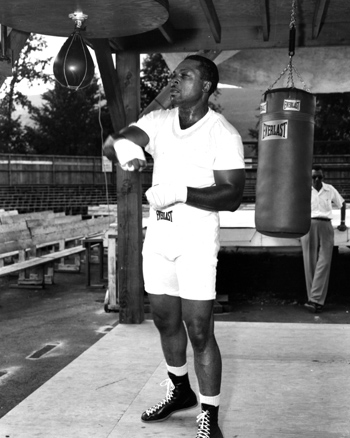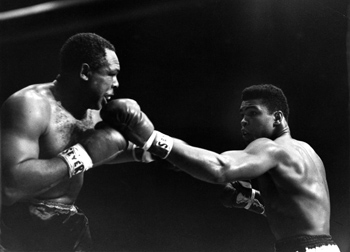10: Best Over-40 Fighters

1. Archie Moore: Record after age 40 — 26-2-2 (16)
When it comes to old-man boxing, nobody has yet to touch “The Old Mongoose.” Moore was as sly about his age as he was in the ring but after his death in December 1998 U.S. Census records revealed that Moore was born on December 13, 1916 instead of the same date in 1913 most often cited. Therefore, for the purposes of this article, the latter date will be used as the benchmark.
 When “Ancient Archie” turned 40 on December 13, 1956 he was shaking off the effects of his second failed crack at the world heavyweight title against Floyd Patterson, who, by winning, became the youngest man ever to win the undisputed heavyweight title and thwarted Moore’s attempt to become the oldest. Still, Moore was the reigning light heavyweight champion, a title he had held since December 1952 when he dethroned Joey Maxim in his adopted hometown of St. Louis.
When “Ancient Archie” turned 40 on December 13, 1956 he was shaking off the effects of his second failed crack at the world heavyweight title against Floyd Patterson, who, by winning, became the youngest man ever to win the undisputed heavyweight title and thwarted Moore’s attempt to become the oldest. Still, Moore was the reigning light heavyweight champion, a title he had held since December 1952 when he dethroned Joey Maxim in his adopted hometown of St. Louis.
After his first failed heavyweight title challenge against Rocky Marciano in September 1955, Moore spent most of his time fighting the big men at between 186¾ and 206¾ pounds, slimming down to 175 only when it was time to defend his title. No matter what Moore weighed his game was the same: Economical foot movement, a rolling crab-like defense and short, crisp, powerful counters that still had enough kick to separate opponents from their senses.
Moore’s post-40 career began with two heavyweight fights against Hans Kalbfell (W 10) and Alain Cherville (KO 6), for which he weighed 206 1/2 and 189 respectively. Moore required six trips to the scale before his initial over-40 defense against Tony Anthony in September 1957 but when it came time to fight he had enough in the tank to score knockdowns in the sixth and seventh to put his 21-year-old opponent away.
The next 14-plus months saw Moore campaign at heavyweight and post a 11-0-1 (5) record. His best victories during this stretch came against Eddie Cotton (W 10), Bert Whitehurst (KO 10), the 225-pound Bob Albright (KO 7), Willie Besmanoff (a split W 10), Charlie Norkus (W 10) and Howard King (W 10). The only blemish in this stretch was a 10-round draw against King in the immediate rematch.
Four months after drawing with King, Moore engaged in his signature fight against muscular French-Canadian  fisherman Yvon Durelle at Montreal’s Forum. Just three days shy of his 42nd birthday, Moore looked all but done in round one when he was floored three times. Another knockdown in the fifth only added to Moore’s mathematical woes but the wisdom collected over 205 fights enabled him to claw his way back into the fight.
fisherman Yvon Durelle at Montreal’s Forum. Just three days shy of his 42nd birthday, Moore looked all but done in round one when he was floored three times. Another knockdown in the fifth only added to Moore’s mathematical woes but the wisdom collected over 205 fights enabled him to claw his way back into the fight.
Starting in the sixth, Moore’s intelligent jabbing, tight defense and thudding counters allowed the old war horse to pile up points and gradually wear Durelle down. The Canadian’s powerful blows became more ponderous with every passing round, which allowed Moore to draw a bead in terms of timing. A series of right hands dropped Durelle late in round seven and a beautifully delivered three punch volley capped by a left uppercut to the chin drove the challenger to all fours in the 10th. The bell saved Durelle — but only for the next 60 seconds. A cluster of rights followed by a hook decked Durelle early in the 11th and a smashing final right culminated the most amazing comeback of Moore’s career.
The rematch with Durelle occurred five months after a 192-pound Moore dispatched the 212-pound Sterling Davis in three rounds. This time the dramatics were one-sided as Moore scored four knockdowns in round three to salt away the KO.
Three fights later Moore suffered his first over-40 loss to Giulio Rinaldi in Rome, a fight that saw Moore floored in the 10-rounder’s final moments. The two met again, this time for the New York version of the light heavyweight title (Moore was stripped of full recognition October 1960) in June 1961 at Madison Square Garden. The 44-year-old Moore was in fine form as he comprehensively out-boxed his cruder opponent and captured a unanimous decision. It would be his final fight at 175.
 Moore added to his record-setting knockout total with short nights against Pete Rademacher (KO 6), Alejandro Lavorante (KO 10) and King (KO 1). Moore then fought a 10-round draw against Willie Pastrano, who 13 months later won the light heavyweight championship from perennial Moore foe Harold Johnson.
Moore added to his record-setting knockout total with short nights against Pete Rademacher (KO 6), Alejandro Lavorante (KO 10) and King (KO 1). Moore then fought a 10-round draw against Willie Pastrano, who 13 months later won the light heavyweight championship from perennial Moore foe Harold Johnson.
One month before his 45th birthday Moore met a lightning-fast 20-year-old named Cassius Clay – later to become Muhammad Ali. Clay’s flashing fists overwhelmed the elderly warrior, who, as Clay predicted, fell in four courtesy of three knockdowns. Moore’s final recorded match came exactly four months later against wrestler Mike DiBiase, a match that stemmed from a dispute during a wrestling match Moore had refereed. “The Mongoose” savaged his inexperienced foe and opened a gash severe enough to stop the bout 20 seconds into round three.
*
Photos / Hoganphotos/Golden Boy Promotions (Hopkins by Rich Kane), Getty Images (Foreman by Barry Jarvinian, Holmes-Holyfield by Andrew D. Bernstein, Hopkins-Tarver by Tom Briglia, Hopkins Pavlik by Jeff Zalevansky,Malinga-Benn by John Gichigi), AFP (Klitschko-Chisora by Christof Stache), THE RING (all magazine covers and Moore photos)
Lee Groves is a boxing writer and historian based in Friendly, W.Va. He is a full member of the BWAA, from which he has won seven writing awards, including four in the last two years. He has been an elector for the International Boxing Hall of Fame since 2001 and is also a writer, researcher and punch-counter for CompuBox, Inc. He is the author of “Tales From the Vault: A Celebration of 100 Boxing Closet Classics. To order, please visit Amazon.com or e-mail the author at [email protected] arrange for autographed copies.














